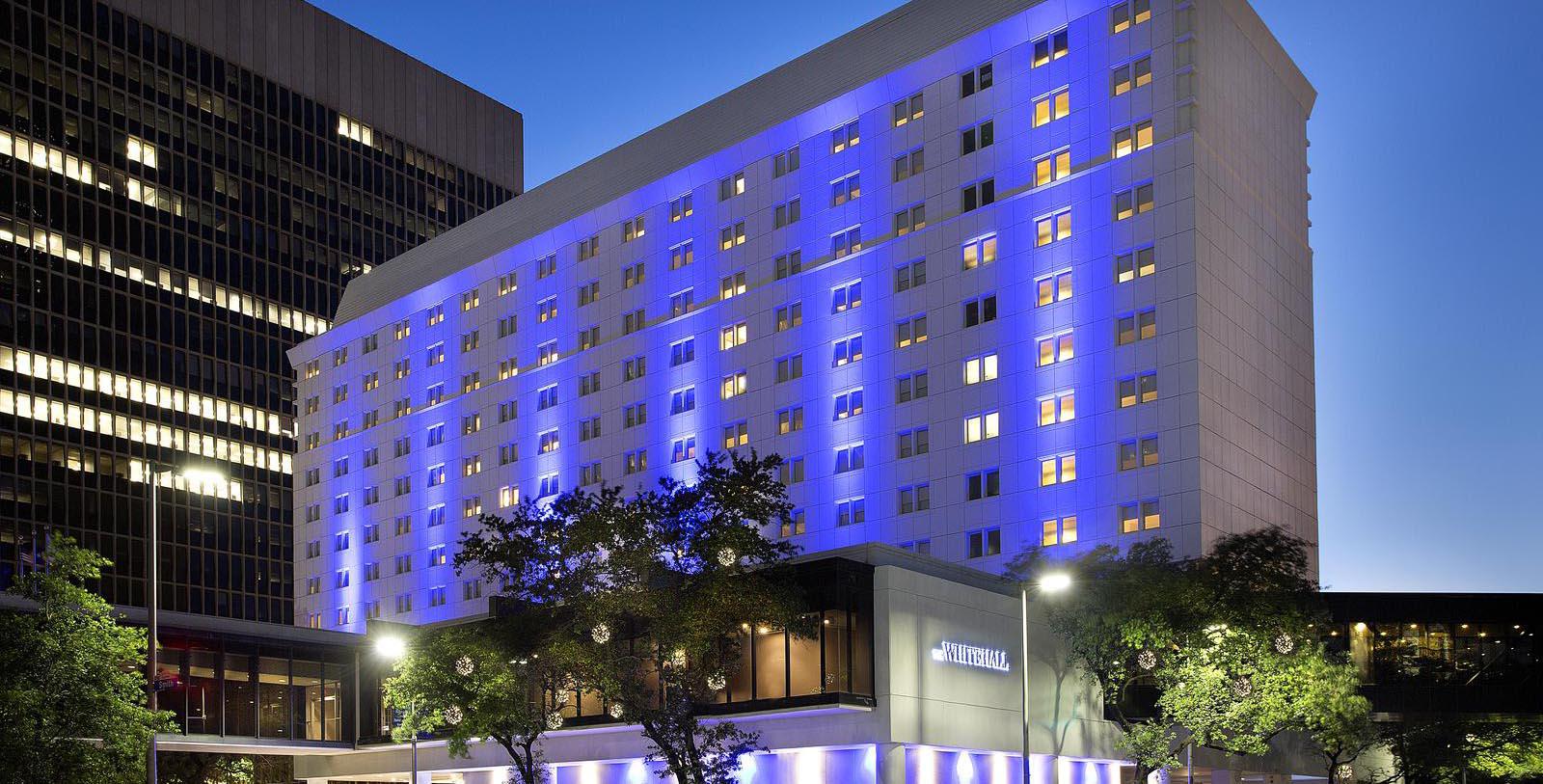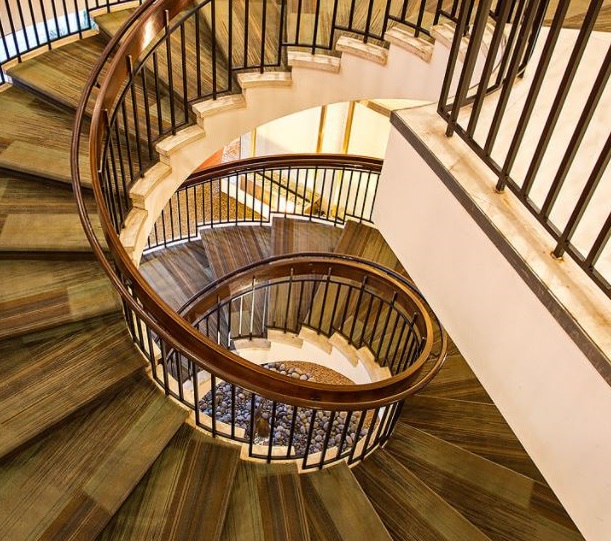Receive for Free - Discover & Explore eNewsletter monthly with advance notice of special offers, packages, and insider savings from 10% - 30% off Best Available Rates at selected hotels.
history
Discover The Whitehall, Houston’s original landmark hotel with a Mid-Century Modern architectural style.
A member of Historic Hotels of America since 2013, The Whitehall has been a fixture in Houston’s Central Business District since the mid-20th century. First opened in 1963, this fantastic boutique hotel has built a celebrated reputation for its unrivaled hospitality and spectacular elegance. Renowned architectural firm Welton Becket and Associates designed the building, which was one the largest architectural firms in the United States at the time. Welton Becket and his partner, Walter Wurdeman, developed the concept of “total design,” whereby the firm would plan all aspects of the hotel’s identity. Such an approach included influencing its engineering, interiors, furniture, fixtures, landscaping, and signage. Their unique architectural philosophy affected the dining space, too, in which everything—from the silverware and napkins to the menus and matchbooks—were included within the overall design. Many of the original hallmarks of the firm’s plans remain today, such as the spiral staircase connecting the first and second floor, as well as the brilliant white Italian marble flooring. Beckett and Wurdeman’s vision proved to be a resounding success, as The Whitehall became one of Houston’s leading holiday destinations. Illustrious patrons from across the country started staying at the hotel regularly, such as Bob Dylan, Graham Nash, and the popular husband-wife duo, Sonny & Cher. In one memorable occasion, the great Elvis Presley relaxed in a suite while preparing to perform at the Houston Rode in 1970. Nevertheless, The Whitehall’s initial success gradually faded as it struggled to compete with a new generation of hotels opening all over Houston. By the late 1980s, the once brilliant hotel was a shadow of its former self. With no way to keep the business viable, its owners decided to close the doors in 1991.
After sitting dormant for close to a decade, a group of investors affiliated with the Maryland-based MHI Hotels intervened and saved The Whitehall. The partners purchased the facility and invested around $25 million into restoring the cherished local landmark back to its former glory. Taking nearly two years to complete, the gorgeous, Mid-Century Modern structure reopened as the “Crowne Plaza Houston Downtown” in 2001. Then, in 2013, a new ownership team—Sotherly Hotels, Inc.—acquired the historic hotel for more than $30 million. It quickly set about completing its own series of renovations that were far greater than those undertaken by MHI Hotels. Costing some $4.8 million, it encompassed the entire building, including every single one of its guestrooms and public spaces. Its food and beverage outlets received extensive attention, too, in which its casual coffee bistro, Buffalo Bayou Coffee, and its outdoor dining establishment, Part & Parcel, underwent massive overhauls. In 2016, the hotel finally debuted once more as “The Whitehall” to great acclaim. The Whitehall has since resumed its former status as one of Houston’s most desirable vacation retreats. Perhaps the greatest symbol of its revitalization has been the return of its influential clientele, which have even included former U.S. President Barack Obama. Few places in Houston are better for a relaxing vacation than The Whitehall. Today, the hotel is directly connected via skywalk to more than 2 million square feet of Class A office space, with major tenants such as KBR, Chevron, and United Airlines. Superbly located, local and tourist attractions such as the George R. Brown Convention Center, Rice University, and Houston’s Theatre District—the second largest in the United States next to New York City—are easily accessible.
-
About the Location +
The earliest known permanent settlement to inhabit the region was a small town called “Harrisburg,” which consisted of American settlers from the Northeast, as well as families of Tejanos. Now a neighborhood within modern-day Houston, the town was named after its founder, Jon Richardson Harris, in 1826. Harrisburg—and its surrounding locale—were governed in the state of Coahuila y Tejas by the newly-minted Mexican government. But when the Texas Revolution erupted a decade later, the armies of General Antonio López de Santa Anna (who was also President of Mexico) passed through Harrisburg and torched it to the ground. Santa Anna was specifically pursuing the Texas patriot Sam Houston, who had helped organize the uprising. Fortunately for the revolting Texans, Houston managed to evade capture and ultimately led his own forces victory at the Battle of San Jacinto in 1836. Fought only a few miles away from the current city limits, Houston’s men routed the Mexicans with a surprise attack that saw General Santa Anna captured. Afterward, Sam Houston and his fellow compatriots formed the Republic of Texas, with Houston himself serving as its first president. Several months after the Battle of San Jacinto, two brothers—Augustus Chapman Allen and John Kirby Allen—bought a sizable tract of property near the desolated Harrisburg and proceeded to erect a new settlement. Christening the town after Sam Houston, the men almost immediately began advertising the town in the Telegraph and Texas Register. They even successfully lobbied the Republic of Texas Congress to move its facilities to Houston, designating the nascent community as the region’s temporary capital.
Still, Houston grew slowly over the next several years as epidemics and poor weather harassed the community. The government also relocated the legislature further away to the City of Austin in 1839. Nevertheless, it developed a vibrant local economy that was intertwined with the maritime commerce of nearby Galveston. Soon enough, many throughout Texas—now a state—regarded Houston as an important economic center. Perhaps the greatest symbol of the city’s financial repute was the arrival of the railroads in 1853. Many local farmers used Houston—and its railroads—as a means of transporting their goods down to Galveston’s wharves. Cotton and sugar quickly emerged as the principal export, as wealthy planters form elsewhere in the South established massive plantations on the outskirts of the city. Thousands of enslaved African Americans thus lived around Houston in the antebellum, with many arriving via the slave auction houses in New Orleans. But the outbreak of the American Civil War eventually brought slavery to an end. While Houston itself remained relatively isolated from the dangers of the conflict, many rebel sailors and privateers often hid inside the city when attempting to break the local Union naval blockade. Its various railroad lines also transported material to many other cities throughout the South, and it briefly served as the headquarters for the Confederacy’s Trans-Mississippi Department. Yet, with the Union victory in the spring of 1865, Houston rejoined the nation, and its enslaved population was freed.
Houston recovered swiftly from the American Civil War, resuming its previous status as one of the region’s most prolific commercial centers. More railroads began opening in the city, with as many as 12 active in 1891. Yet, the discovery of oil nearby introduced a profitable new industry for Houston that incentivized thousands of new people to move to the area. Dozens of refineries opened with the debut of the Houston Ship Channel, employing scores of workers for decades. By the 1930s, Houston had become Texas’ most populous community. Further economic developments transpired during World War II, when the city became a major participant in the shipbuilding trade. One of the largest companies in operation at the time was the Brown Shipbuilding Company, which helped develop vessels for the U.S. Navy. The petrochemical industry also exploded as the national war effort greatly required the use of its products. The economic boom persisted well into the middle of the century, which indirectly spurred the creation of NASA’s Manned Spacecraft Center on Houston’s outskirts in 1961. Known today as the Lyndon B. Johnson Space Center, the facility served as the command post for every human spaceflight mission since Gemini 4. Additional developments to appear within the city included the creation of the legendary Astrodome, the former home to the Houston Astros baseball team and the world’s first domed indoor sports stadium. Today, Houston is among the most exciting places to visit in Texas. The Whitehall is situated perfectly to help with such an exploration, too. A number of amazing cultural attractions are located nearby, including the George R. Brown Convention Center, Rice University, and Houston’s Theatre District, which is the second largest in the United States next to New York City!
-
About the Architecture +
Originally opened in 1963, The Whitehall was first designed by the renowned architectural firm, Welton Becket and Associates. At the time, Becket’s firm was one of the largest architectural companies in the United States. He specifically worked alongside his colleague, Walter Wurdeman, to create the building’s iconic appearance. The two used their own architectural concept known as “total design,” in which every facet of the structure—from its décor to its engineering—were part of the overall design. Becket and Wurdeman were also proficient adherents of Mid-Century Modern architecture, which they used to create The Whitehall. An offshoot of the earlier International and Bauhaus movements, Mid-Century Modern essentially sought to portray a seemingly contemporary, futuristic aesthetic that reflected the popular concepts of civil progress. Professional architects mainly utilized the style from the 1930s to the 1960s, when American society was rapidly undergoing huge transformations—both social and technological in nature. Architects thus embraced the design ideals of function, simplicity, and rationality in order to create sleek-looking structures that possessed a communal purpose. As such, Mid-Century Modern designs made explicit use of vertical, flat lines and irregular rectangular shapes that conveyed a lack of formality. Overt ornamentation was abandoned, too, as monochromatic brickwork, steel, and concreate served as the essential building blocks for the exterior. Inside, most of the rooms were subdivided into split levels, giving a sense that the structure had undergone a significant change in elevation. Modernist buildings also featured wide, open spaces filled with natural light that represented practicality and comfort. Large widows often functioned as the primary way in which the architects achieved such a feature. The introduction of spacious windows even sought to better incorporate nature into the design, making the surrounding landscape seem as if it were part of the building itself.
-
Famous Historic Guests +
Elvis Presley, singer and actor celebrated today as the “King of Rock and Roll.”
Bob Dylan, Grammy-Award musician known for such singles as “Blowin’ in the Wind,” and “The Times They Are a-Changin’.”
Sonny Bono, former member of the husband-wife duo, “Sonny and Cher” and member of the U.S. House of Representatives.
Cher, singer regarded as the “Goddess of Pop” and former member of the husband-wife duo, “Sonny and Cher.”
Graham Nash, singer and songwriter of the renowned musical group, “Crosby, Stills, & Nash.”
Barack Obama, 44th President of the United States (2009 – 2017)



































